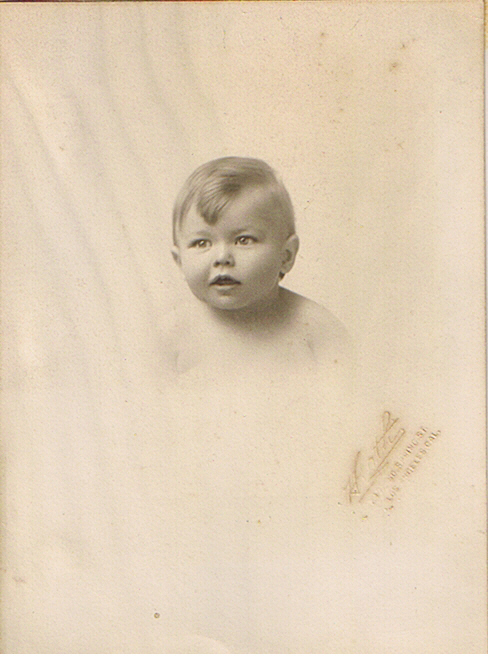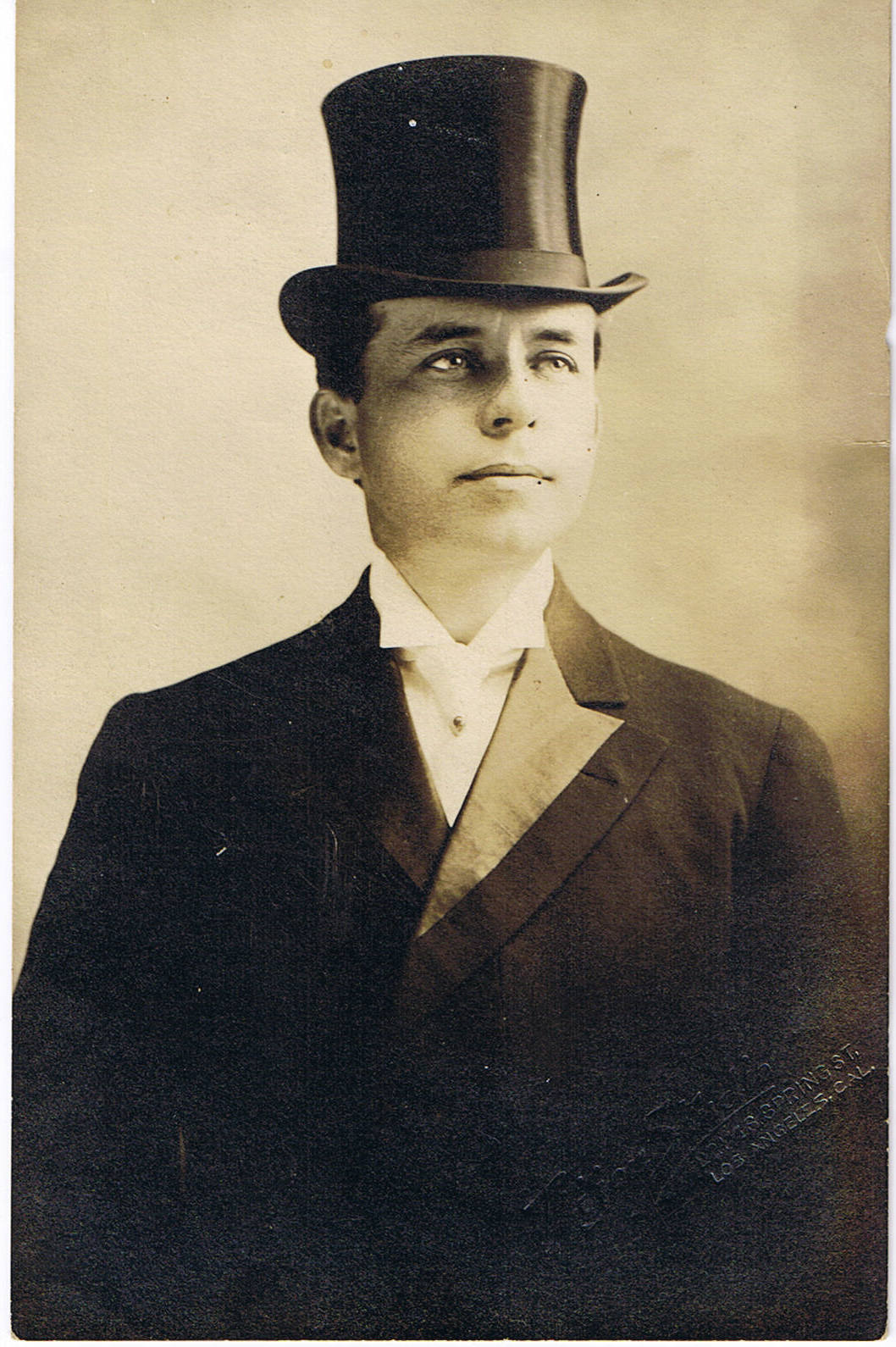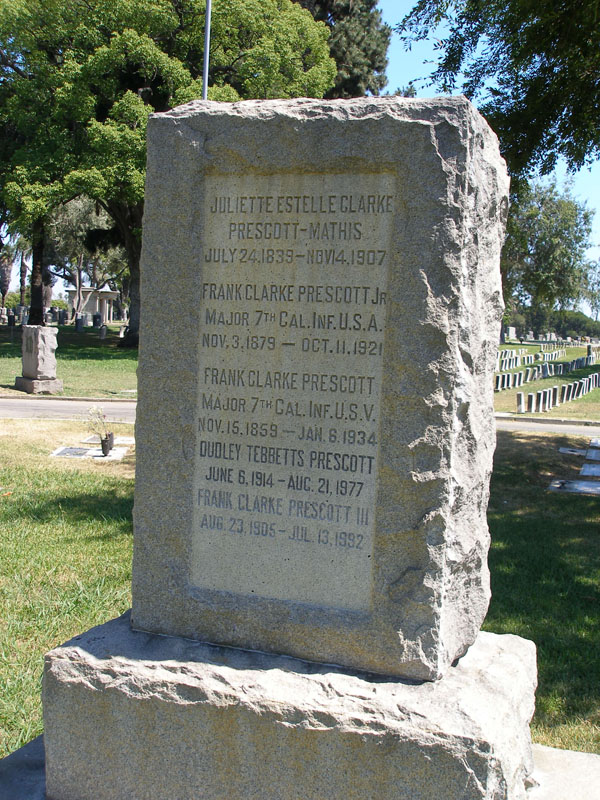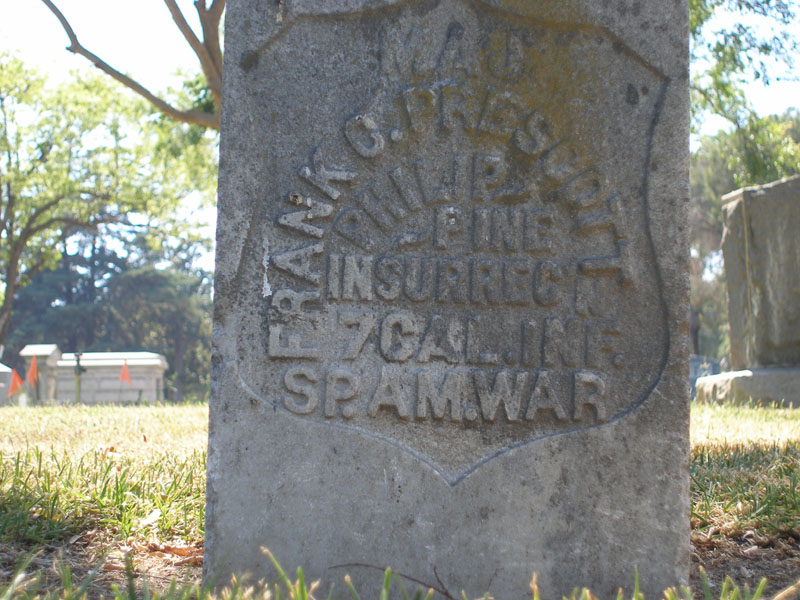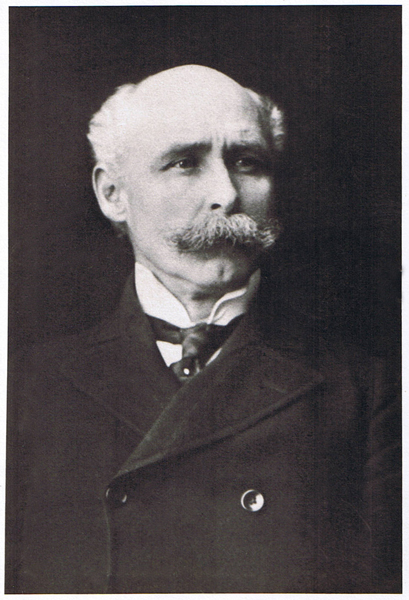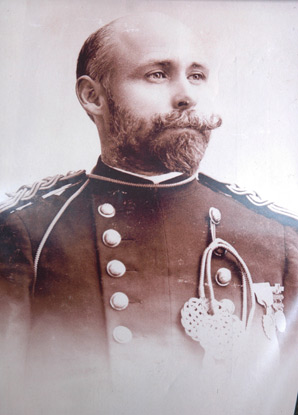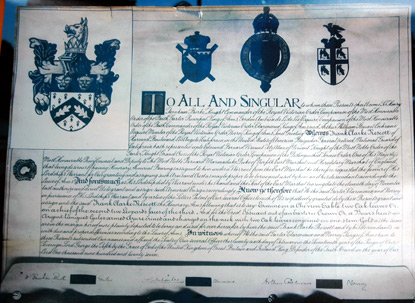| Citations |
- Frank C. Prescott, of Redlands, was born on November 15, 1859, at Ottawa, Lasalle County, Illinois, where he attended public schools. He moved to California in 1876.
General Prescott began his military career as a private in the Oakland Light Cavalry, National Guard of California, in 1878. Later, after relocating to Southern California, he assisted in the formation and was elected the First Lieutenant of the Redlands Guard, an independent company, which was mustered into the National Guard as Company G, Ninth Infantry, June 3, 1893.
In 1898, when the Seventh Regiment went to San Francisco and was mustered into the United States Volunteers, Major Prescott's battalion won especial notice for its fine discipline and drilling. Although the Seventh Regiment was not taken to the Philippines, Major Prescott secured a commission as Captain in the 53d Infantry, U.S.V., and saw active service during the Philippine Insurrection. He was then recommended for promotion as Major of volunteers by brevet for meritorious service. While in the Philippines his legal abilities were recognized and he was appointed Provost Judge of the Island of Samar, and was called upon to render services in a number of instances. He was detailed on the staff of General Hughes, and made supervisor of internal revenue for the Department of the Visayas. [A fuller account of General Prescott's services and those of his regiment in active field work in the Philippines as well as of the Seventh Regiment, will be found in the military history of the county].
In the fall of 1903, Major Prescott was promoted to the rank of brigadier-general in command of the First Brigade, N.G.C., by Governor Pardee.
Outside the military, Gen. Prescott began his career in the telegraph business in 1876. His uncle, George B. Prescott, was the first general electrician of the Western Union Telegraph Company, and one of the earliest writers on the subject of telegraphy. In the telegraph business, General Prescott occupied many important positions. He was manger of the San Diego office of the Western Union in 1887, chief operator of the Oakland office from 1878 to 1882, when the relaying business handled there prior to the laying of the cables across the Bay made a large force necessary. During the stirring times of the Geronimo campaign in Arizona he was manager of the Tombstone office and there formed the acquaintance of General Lawton. This acquaintance ripened into a lifelong friendship, which after years was useful to the one-time telegrapher in military activities.
Fifteen years of telegraphy, some of them spent in working the heaviest overland press wires out of San Francisco and Los Angeles, were broken by one year, 1883-84, in the newspaper business, as editor of the Santa Barbara Daily Independent.
The law, however, which from the beginning had been his ambition as a profession, claimed his best efforts and had been his study during all the years of telegraphy. At the April term, 1888, of the Supreme Court of California, at Los Angeles, he was admitted to practice law. He at once entered the office of John D. Bicknell, where he remained a year. Later he entered into a law partnership with Hon. R. B. Carpenter. Upon leaving Los Angeles in 1892, General Prescott moved to Redlands. Here, he was admitted to practice in the Circuit Court of the United States for the Ninth Judicial Circuit on July 1, 1889, and in the District Court of the United States for the Southern District of California on September 16, 1901. Here too, he served as the city attorney of Redlands. In January 1903 he entered into a law partner ship under the firm of Prescott & Morris, his office being located in San Bernardino.
In 1895 he was the law clerk of the judiciary committee of the assembly in the legislature of the state of California. The duties of this position brought him into touch with the greater part of the more technical points in law-making. In November, 1902, he was elected assemblyman of the Seventy-sixth assembly district, representing San Bernardino county. As legislator he was a member of the Ways and Means, Judiciary, Military, and State Hospital committees, also chairman of the Committee on State Library. In November 1904, he was re-nominated by acclamation for the same office by the Republican party. He served as Speaker of the House during the 36th Assembly.
Prescott, Frank Clarke, b. Nov. 15, 1859, Ottawa, Ill; d. Jan. 6, 1934, L.A. Ex officio Regent as speaker of the assembly, 1905-06. Career: telegrapher, 1876-88; practiced law, 1888-91, L.A., 1891-1903, Redlands, 1903-06, San Bernardino; Redlands city atty., 1899; assemblyman from San Bernardino, 1903-06, speaker, 1905-06; register, U.S. Land Office, 1906-10, L.A; senior member, Prescott and Prescott, 1910-34. Enlisted as private, Oakland Light Cavalry, N.G.C., 1880; retired as brig. gen., 1903; major, Spanish-American War; capt., Philippine Insurrection; provost judge, 1900, Island of Samar; brigadier staff, 1900-01, Iloilo
California State Milita and National Guard Unit Histories
A Brief History
of the
San Bernardino County Companies
of the First Battalion, Seventh Infantry, N.G.C.
By Mark J. Denger
California Center for Military History
The history of the formation of the Seventh California Infantry, United States Volunteers, owes much of its history and origin to the original San Bernardino County Companies of the First Battalion of the Seventh Infantry, California National Guard.
Waterman Rifles
The history of Company E, Seventh Infantry, National Guard of California rightly begins with the Waterman Riffles of the City of San Bernardino, an independent company of infantry, which was formed in the early part of 1887. The California legislature, in the spring of 1887, had provided for an increase of the National Guard, which led to the formation of the Waterman Rifles, with a view to their being ultimately mustered into state service. The name of the Waterman Rifles was selected as a compliment to the Governor, which he generously acknowledged. At that time, R. W. Waterman, a citizen of San Bernardino, had been elected Lieutenant Governor of California in November, of 1886, and became Governor on September 12, 1887, on the death of Washington Bartlett.
The original officers of the Waterman Rifles were as follows: William J. Wilsey, Captain; George L. Bryant, First Lieutenant; Myron W. Littlefield, Second Lieutenant; and James E. Mack, as First Sergeant.
The original officers and members of the Waterman Rifles were officially mustered in service on October 29, 1887, as Company E, Seventh Infantry, National Guard of California.
The Seventh Regiment Band owes its origins to the Waterman Rifles, and the following Musicians: George Blake, C. L. Sears, D. C. Ross, J. A. McDonald, W. H. Hale, J. D. Folks, J. W. Driver, John E. Bailey, George S. Nickerson, Fred E. Moore, Oscar D. Foy, F. G. Erbie, and Louis Ancker, Jr.
The company remained with the original Seventh Infantry until the formation of the Ninth Infantry, N.G.C., to which Company E was transferred with its original letter.
Upon the disintegration of the Ninth Infantry, under Regiment General Order 17 and Adjutant General Order dated December 7, 1895, Company E was provisionally assigned to the Second Battalion of Infantry of the First Brigade, National Guard of California, and two days later, General Order 18, dated December 9, 1895, designated Company K, and transferred to the First Battalion, Seventh Infantry, National Guard of California.
Company K rendezvoused at Redlands, May 5, 1898, and was, with the rest of the regiment, mustered into the Seventh California Infantry, United States Volunteers Independent Division, Eighth Army Cops, United States Army.
The following men were elected its officers and non-commissioned officers: O. P. Sloat, Captain, Commanding; Wm. C. Seccombe, First Lieutenant; Arthur F. Halpin, Second Lieutenant; J. D. Mathews, First Sergeant; W. A. Rowntree, Quartermaster Sergeant; W. G. Bodkin, C. S. Rollins, B. W. Allen, D. W. Strong; Corporals, D. L. Whitlock, I. S. Martin, John Hall, E. I. Cleveland, E. L. Barrows; and N. S. Young, Artificer.
The following members of Company K rendered service in the Philippines: Don L. Noble*, D. W. Strong, Ira S. Martin, E. I. Cleveland, H. N. Peck, D. P. Butler, C. E. Crawford, R. Nelson, John Purcell, William H. Ralston, D. H. Sibbett, Theodore H. Tarbox*, L. G. White, C. A. Williams, Harry Johnston, L. W. Planz*. One member, T. B. Robertson, served in the Naval Militia during the Spanish War, and C. O. Hoyt, served in the U.S. Navy.
Redlands Guard
Like the Waterman Rifles, the Redlands Guard was an independent infantry company. The Redlands Guard was organized on Friday evening, June 10, 1892, at the Society Hall, in the Feraud Building, then located at the corner of Orange and Water streets, Redlands. On the evening following, J. Wallace F. Diss was elected Captain; Frank C. Prescott, First Lieutenant; and James F. Drake, Second Lieutenant. The original members included the following: First Sergeant: Harvey E. Higbey; Sergeants: Musgrove, Steele; Corporals: E. J. Underwood, E. E. Raught, J. W. Edwards, John F. Byrne, Charles Howard; Privates: C. A. Wise, Charles Roberts, J. F. Dostal, Herman Yorker, T. S. Holliday, Ruggles, John Rundberg, Chapman, Young, Holliday, F. N. Chevalier, Charles W. Lehr, B. R. Sheldon, J. A. Weitzel, A. C. Fowler, J. F. Sutherland, A. R. Welton, George S. Biggin, W. W. Dingwall, Fred Higinbotham, William Koehler, Will Bryan, L. A. Pfeiffer, Jacob maier, John Carlson, and S. Kenady.
Drilling began regularly on Thursday nights, and uniforms were soon provided. One of the stores in the brick building, where the Casa Loma was afterwards built, was used as an armory.
In August, 1892, the company went to Camp Butler, at Long Beach, under the command of Lieutenant Prescott, Captain Diss being there during the camp as a guest of the National Guard. Here Adjutant General Allen entertained a plan, whereby state Springfield rifles were stored with and used by the company.
On June 3, 1893, the independent company formerly called the Redlands Guards was officially mustered into the Ninth Infantry, National Guard of California, as Company G, with the following members appointed as its officers: J. Wallace F. Diss, Captain; Frank C. Prescott, First Lieutenant; and Harvey E. Higbey, Second Lieutenant.
Upon the disintegration of the Ninth Infantry, under Regiment General Order 17 and Adjutant General Order dated December 7, 1895, Company G was assigned provisionally to the Third Battalion of Infantry of the First Brigade, National Guard of California, and two days later, General Order 18, dated December 9, 1895, retaining its old letter, was transferred to the First Battalion, Seventh Infantry, National Guard of California.
Company G rendezvoused at Redlands, May 5, 1898, and was, with the rest of the regiment, mustered into the Seventh California Infantry, United States Volunteers, Independent Division, Eighth Army Cops, United States Army.
The following men were elected its officers and non-commissioned officers: George S. Biggin, Captain, commanding; George M. Smallwood, First Lieutenant; Lewis Palmtag, Second Lieutenant; G. E. Cryer, First Sergeant; Frank Cook, Quartermaster Sergeant; Sergeants H. F. H. Brown, L. K. Brown, J. E. Hosking, and Jacob Kircher; and Corporals E. S. Logie, W. H. Fletcher, C. F. Ford, A. G. Reynolds, O. H. Burton, A. R. Welton, Chas. J. Johnson, Arthur W. Hunt, Geo. A. Webber, Jno. A. Mack, Harry C. Lockwood, Will L. Fowler; Artificer, A. C. Sherman.
The following members of Company G performed duty in the Philippines: Frank C. Prescott, 43rd Infty., U.S.V; J. Wallace F. Diss, California Heavy Artillery; U.S.V; John G. Baldridge, 43rd Infty., U.S.V; W. D. Timmons, 43rd Infty., U.S.V; F. J. Michaelis, U.S.A; G. Willett, 35th Infty., U.S.V; Charles R. Ferguson, 43rd Infty., U.S.V; H. H. McCormick, 3rd Artillery, U.S.A; F. J. Valdez*, 18th Infty., U.S.A; Arthur L. Dean*, U.S. Art., U.S.A; Geo. Moseley, U.S. Art., U.S.A; M. Royal, 43rd Infty., U.S.V; George J. Beasley, 43rd Infty., U.S.V; W. E. Foster, U.S.A.
First Battalion, Seventh Infantry, National Guard of California
The addition of the Redlands Company, and by the Act of March 9, 1893, which added another major to the field of the Ninth Regiment, resulted in an election at San Diego on June 17, 1893, to which Frank C. Prescott was elected major of the Second Battalion, which included Companies C of Riverside, G of Redlands, E of San Bernardino and D of Pamona.
At the consolidation of the Seventh and Ninth regiments of the California National Guard these companies remained in the same battalion with only their letters changed to that of M, of Riverside, and K, of San Bernardino.
In 1897, at the Santa Monica camp, Company D of Pomona was transferred to another battalion and Company B of San Diego was placed in the battalion, thus giving Captain Dodge of San Diego, the senior officer of the regiment in time of service, the right of the line.
The reorganization also resulted in the battalion becoming the First Battalion as Major Prescott who was re-elected the Senior Major.
Prior to the Spanish-American War, the Battalion had been called upon for active state duty three times:
The first call to arms occurred on September 2, 1893, when the battalion was ordered to rendezvous at the armories of their respective companies for duty in suppressing anti-Chinese riots threatening Redlands. Here the battalion was assemble and remained all night. The battalion was commended in Regimental orders No. 14, Headquarters Ninth Regiment, First Brigade, N.G.C., San Diego, California, September 16, 1893, paragraph V reads as follows:
"The commanding officer desires to commend Major Frank C. Prescott and the officers and men of Companies C, E and G for the promptness with which they responded to the orders of the Brigade Commander upon occasion of the recent threatened anti-Chinese riots at Redlands, and the manner in which they exemplified their readiness to discharge their duties under the law. The large percentage of attendance secured upon short notice, and the energy and efficiency shown in the discharge of duty, justifies the commanding officer's large faith in the fidelity and efficiency of his entire command and in its capacity to properly aid the civil authorities to meet those emergencies of public disorder the danger of whose occurrence justifies the National Guard's existence.
By Order of Colonel Spileman
Official
Ed. F. Brown, Adjutant."
The Battalion's first tour of active state duty was characterized by good judgment and efficiency.
The second took place on April 14, 1894, when the battalion was ordered to rendezvous and with Company K to proceed to Colton to protect railroad property from the Coxey Army riotous demonstrations. Company K bivouacked one night at the City Hall, Colton. At the time of the industrial troubles the preservation of peace was accomplished without immoderate zeal or supine indifference.
The third occasion took place on May 5, 1898, when the battalion was assembled at armories and ordered to San Francisco. The battalion started for San Francisco on May 6, 1898, camped at Presidio on May 7, 1898, and were mustered into the United States Volunteers for service in the Spanish-American War on May 9, 1898. In camp at the Presidio, May 7 to 25 inclusive; the battalion took station at Camp Merritt on June 28, 1898 and returned to the Presidio on August 24, where it was furloughed on October 13, with orders to rendezvous at Agricultural Park in Los Angeles on November 12, 1898. There the battalion was mustered out on December 2, 1898, and returned to duty with National Guard.
Seventh California Infantry, United States Volunteers, Eighth Army Corps
While in the service of the United States as the First Battalion of the Seventh California Infantry, United States Volunteers, it was part of the First Brigade, Independent Division of the Eighth Army Corps, and was always a part of the Expeditionary Forces. Its officers were Major Frank C. Prescott and First Lieutenant Harvey E. Higbey.
The tour of duty at the Presidio was one of instruction and discipline. Major Prescott carried out the work to the uttermost limit. The battalion was soon drilling in both close and extended order by trumpet signals. The infantry drill regulations were covered. The work culminated in the exhibition drills given by the different regiments on different nights at the Mechanics' Pavilion. The battalion was repeatedly commended in orders and was distinguished for its instruction, discipline and esprit. Movements of the close order were fully exemplified. It was noted and commented upon by Major General Merriam, the reviewing officer, and the press of the city, that at the order "arms," where the iron butts of nearly four hundred rifles stuck the board floor together, not a sound was heard. This was conformable to the infantry drill regulations which prescribe that the guns shall be lowered gently to the ground. The perfection of discipline will be appreciated that will bring hundreds of rifles down to a hard floor without a sound. This was a unique refinement of military precision. The efficiency of the battalion was recognized by the regular army authorities who ordered it for a tour of duty wherein the captains were ordered to fall out and regular army lieutenants placed in command of the companies to test their proficiency of drill. This was reported by one of the San Francisco newspapers as follows:
"First and Second Lieutenants of the United States Army undergoing examination for promotion, were examined in drill June 14, 1898, Major Prescott's battalion of the Seventh California Infantry, U.S.V., was brought over from Camp Merritt to the Presidio for the purpose of examination. It was a matter of universal comment among the officers of the Presidio what a fine body of men the soldiers of the battalion were, excellently drilled and strong and martial in appearance."
Company L, Forty-Third Infantry, United States Volunteers
The battalion was mustered out on December 2, 1898, and after the muster out from the volunteer service the battalion returned to duty in the National Guard.
During the Spanish-American War, many of its members enlisted in the United States Army, United States Navy or volunteered (re-enlisted) for additional service as part of the United States Volunteers. Among these were the men of Company L, Forty-Third infantry, United States Volunteers.
Company L, Forty-Third Infantry, United States Volunteers
On September 12, 1899, Major Frank C. Prescott, accepted a commission as Captain in the United States Volunteers, with rank dating from August 17, 1899. Returning back to San Bernardino County, on September 22, Major Prescott opened recruiting offices in Redlands and San Bernardino.
Captain Prescott recruited sixteen men from San Bernardino: John G. Baldridge, Dann Perry Butler, Charles G. Clifton, Charles C. Covington, Albert D. Gage, Elmer F. Gleason, Parker B. Greason, Marcus Hawley, Charles J. Kerr, Charles W. Nixon, William H. Ralston, William D. Rosenberg, Theodore H. Tarbox, Lorenzo D. Taylor, Duane H. Timmons and Lemuel Grant White.
This formed the nucleus of Company L of the 43rd Infantry, United States Volunteers. The organization was the contribution of San Bernardino County to the Philippine campaign.
When Captain Prescott began recruiting at Redlands on September 22, 1899, Captain Cooke began recruiting at Sacramento on September 21, 1899. Captain Prescott arrived at the Presidio of San Francisco with fifteen recruits on October 14, and Captain Cooke arrived with eight recruits on October 11. These, with assignments from general recruiting stations, were consolidated, equipped and instructed by Captain Prescott and the provisional company mustered in as Company L, 43d Infantry, United States Volunteers, and mustered in roll dated November 3, 1899.
The company marched from the Presidio of San Francisco at 11 a.m., on November 20, and arrived on board of United States chartered transport CITY OF PUEBLA at 12:45 p.m., and sailed that same day at 5 p.m., for the Philippine Islands, with First Battalion, 44th Infantry, U.S.V., on board. The City of Puebla traveled in the company with the transport U.S.A.T. HANCOCK. They arrived at Honolulu, Hawaiian Islands, on November 28, and on the 30th, the company, with First Battalion, 44th Infantry, took a march of six miles and witnessed a camp of instruction and drill of the National Guard of Hawaii.
Company L sailed with the Battalion from Honolulu on December 3, 1899 and arrived at Manila, Luzon, Philippine Islands, on December 19, 1899, where they learned that Major General H. W. Lawton, whose home was at Redlands, had been killed that day. Landing at Manila, the company was quartered at the Exposition Building, Malate, on December 21, 1899. From here they marched to El Deposito de las Aguas Potables, Maraquina Crossing, on December 22, a distance of six miles, and camped in tents already erected there. The company moved into tents 100 yards distant in front of the Headquarters of the First Brigade, First Division, Eighth Army Corps, El Deposito, on Saturday, December 23. From here they marched four miles to a pumping station and was ferried across the San Mateo river to Santolan where they bivouacked for the night (December 26). The company was then ordered to march eight miles to San Mateo, escorting twenty-nine carabao wagons loaded with supplies, and arrived at 10 a.m. on December 27, having marched toward heavy fire in hills for last four miles. Upon their arrival, the company was held in reserve and participated in action in mountains back of town. Marching back to El Deposito, with two wounded, the company arrived back at camp at 12:20 a.m. on December 28, 1899. The afore mentioned action being the first engagement against the enemy by any part of the 43rd regiment.
After nearly a year and a half of combat in the Philippines, on May 31, 1901, Company L boarded the transport U.S.A.T. KILPATRICK departing from Manila, Luzon, Philippine Islands, arrived at San Francisco on June 27, where they were mustered out of service on July 5, 1901.
- [S2] Records are at a school or University.
|
